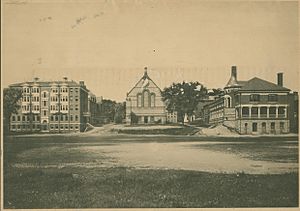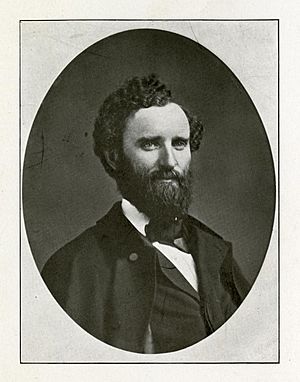James B. Simmons facts for kids
James B. Simmons (born around 1827 – died December 17, 1905) was an important minister and abolitionist. An abolitionist is someone who worked to end slavery. He lived during the time before the American Civil War.
Simmons served as a Baptist minister in several cities. These included Providence, Rhode Island; Indianapolis, Indiana; Philadelphia, Pennsylvania; and New York City. After the Civil War, he became a missionary. He helped lead the American Baptist Home Mission Society from 1867 to 1874. He also helped start Hardin–Simmons University in Texas, which is partly named after him.
Contents
Early Life and School
James B. Simmons was born in North East, New York, in 1827. His father, William Simmons, was a farmer. His mother, Clarissa Roe, died when James was very young.

James had four older brothers and sisters. His brother Edward, who was much older, helped teach him. James also studied at Madison University's (now Colgate University) preparatory school. He decided to become a Baptist after hearing a speaker in Sheffield. Rev. John LaGrange baptized him.
While studying, James worked as a farmer and a teacher. He entered Brown University in 1847 and graduated in 1851. He continued his studies at a seminary in Rochester, New York, with his wife. He finished his education at Newton Theological Seminary in 1854.
Family Life
James Simmons met Mary Eliza Stevens while he was at Brown University. Mary's parents were wealthy Quakers from Rhode Island. Mary was a very good student at her Quaker college. She became a Baptist after meeting James.
They got married on October 28, 1851. Mary was very interested in missionary work. She even studied Greek and Hebrew at the seminary. Their son, Robert, was born on December 9, 1854, in Providence, Rhode Island. Robert later became a doctor.
Simmons's Career
As a Minister
After graduating from Brown, James Simmons became a pastor. He led the Third Baptist Church in Providence, Rhode Island, from 1851 to 1854. In 1857, he moved to lead the First Baptist Church of Indianapolis. In 1861, he became the leader of the Fifth Baptist Church of Philadelphia. Under his guidance, a beautiful church was built. He became known for his skills in raising money and leading his church. Because of his great work, two universities gave him special honorary degrees.
One day, Simmons saw a deputy marshal shoot a runaway slave. This event deeply upset him. He felt that the government's rules were very different from what the Bible taught. This led him to give a powerful sermon called The American Slave System Tried by the Golden Rule. He promised to speak out more strongly about his beliefs. After he preached that everyone is equal and spoke against the governor, his church was set on fire. He also received threats. He wrote a book called The Cause and Cure of the Rebellion.
After he stopped working for the American Baptist Home Mission Society, he became a minister at the Old Trinity Baptist Church in New York. He served there from 1874 to 1882.
Helping After the Civil War
After the American Civil War ended in 1865, four million enslaved people became free. However, they often had no education or ways to get out of poverty. James Simmons was asked to help. He became the secretary of the Baptist Home Missions.
He started many schools in the Southern states for these newly freed people. He began with a Christian school in Richmond, Virginia. In 1865, he helped get $10,000 from the Freedmen's Bureau for Colver Institute. This money was used to buy a hotel in Richmond and turn it into a school. Before that, a former slave prison called Lumpkin's Jail was rented and used as a school. Later, this school became part of Virginia Union University.
Simmons was very important in helping to develop many schools in the South. He helped create schools like:
- Benedict Institute (now Benedict College) in Columbia, South Carolina
- Leland College in New Orleans
- Shaw University in Raleigh, North Carolina
- Wayland Seminary in Washington, D.C.
- The Nashville Institute, which became Roger Williams University, in Nashville, Tennessee
- Augusta Seminary in Augusta, Georgia
He also helped establish Morehouse College. In 1869, he was given the job of developing missions for African American communities in the South and West, and also in Mexico.
Simmons was also a trustee at Brown University. In 1891, he helped found Simmons College, which is now known as Hardin–Simmons University in Abilene, Texas. He set up a fund for a library there, which helped build Anna Hall. He also gave and organized many books for the library.
After his time as a minister, Simmons worked for the American Baptist Publication Society. He raised money for Bible and mission work. He also helped start two more schools. One of these schools became the University of Columbia in Washington D.C. The other was a short-lived school in Indiana.
Death
Mary, James's wife, died on September 24, 1894. She was buried in a Quaker cemetery near Providence. James Simmons died at his home in New York on December 17, 1905. A service was held at the Fifth Avenue Baptist Church.
James, Mary, and their son Robert are all buried together. Their graves are on the Hardin-Simmons University campus in the Founders' Cemetery. James Simmons once said he hoped that even their "very ashes may witness for Christian Education." This shows how much he believed in the power of learning.




